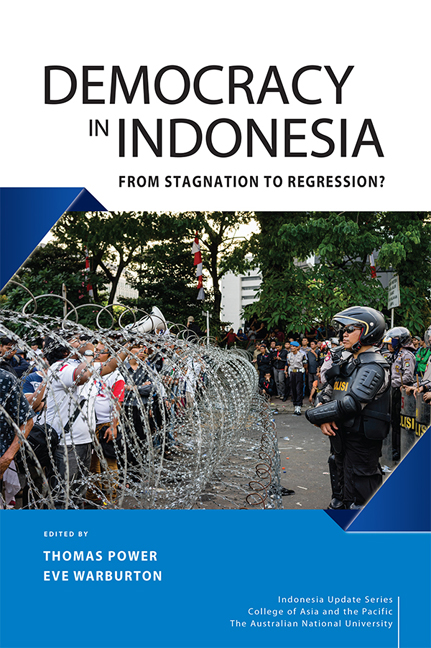Book contents
- Frontmatter
- Contents
- Tables and Figures
- Contributors
- Foreword
- Acknowledgments
- Glossary
- 1 The decline of Indonesian Democracy
- Part 1 Historic al and Comparative Perspectives
- Part 2 Polarisation and Populism
- Part 3 Popular Supp ort for Democracy
- Part 4 Democratic Institutions
- Part 5 Law, Security and Disorder
- Index
- Indonesia Update Series
16 - Rumour, identity and violence in contemporary Indonesia: evidence from elections in West Kalimantan
Published online by Cambridge University Press: 24 November 2020
- Frontmatter
- Contents
- Tables and Figures
- Contributors
- Foreword
- Acknowledgments
- Glossary
- 1 The decline of Indonesian Democracy
- Part 1 Historic al and Comparative Perspectives
- Part 2 Polarisation and Populism
- Part 3 Popular Supp ort for Democracy
- Part 4 Democratic Institutions
- Part 5 Law, Security and Disorder
- Index
- Indonesia Update Series
Summary
The rapid expansion of internet services in Indonesia and in many other developing countries over the past decade has bolstered the circulation of online information. Today Indonesia boasts one of the largest and most active communities of social media users in the world (Jakarta Post 2018). While improvements to telecommunications technology have provided many social, economic and educational benefits, the global digital revolution is widely seen as something of a doubleedged sword. In particular, scholars have identified the expansion of social media technology as allowing for the far more rampant and widespread manipulation and falsification of information (Bradshaw and Howard 2019).
Over the past decade, increasing analytical attention has been paid to the propagation through social media of rumours, misinformation and disinformation, and the profound effects this can have on public opinion and political polarisation. Rumours are unverified stories and uncertain accounts of people, events and occurrences. They may or may not be constructed and deployed with a political agenda, and can take on a life of their own, spreading and evolving in sometimes organic ways. Misinformation is, similarly, unintentionally misleading or unverified content. On the other hand, disinformation—often also described as fake news—is systematically designed and maliciously deployed with an intention to mislead. It is often deployed in service to specific political objectives, such as attempts to influence a voting public.
Rumours and disinformation are longstanding features of electoral politics in Indonesia. However, research on the ways in which these patterns have been affected by the digital revolution—particularly the spread of smartphones, growing use of social media and expansion of internet connectivity—remains in its relative infancy. A burgeoning body of evidence suggests that evolving communications technology has f acilitated r apid, c ost-effective d issemination o f r umour a nd disinformation, producing serious and unpredictable consequences. In recent Indonesian elections, we have seen the emergence of ‘cyber troops’ and political social media campaigners, known locally as ‘buzzers’, who produce disinformation to orchestrate smear campaigns against political opponents, generate and manipulate communal anxieties, and even challenge the legitimacy of democratic processes in a systematic and organised manner (CIPG 2019; Lamb 2018; Potkin and Da Costa 2019).
- Type
- Chapter
- Information
- Democracy in IndonesiaFrom Stagnation to Regression?, pp. 326 - 345Publisher: ISEAS–Yusof Ishak InstitutePrint publication year: 2020

